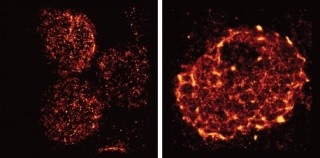Jun 17 2016
White blood cells, also including T cells, need to respond when the body fights an invading pathogen. Researchers from Salk Institute have recently imaged the bundling of critical receptors present on the surface of T cells when activated.
 Salk scientists used light-sheet super-resolution imaging to capture the rearrangement of T-cell receptors from nanometer-scale protein islands (left) to micrometer-scale microclusters (right) after T-cell activation in mouse lymph nodes. Credit: Salk Institute
Salk scientists used light-sheet super-resolution imaging to capture the rearrangement of T-cell receptors from nanometer-scale protein islands (left) to micrometer-scale microclusters (right) after T-cell activation in mouse lymph nodes. Credit: Salk Institute
This is the very first study to visualize this entire process in the lymph nodes, and could also help scientists to improve their understanding on how to turn down or turn up the activity of the immune system for treating infections, autoimmune diseases, and even cancer. The results of the study were reported in the June 13th, 2016 issue of Proceedings of the National Academy of Sciences.
We had seen these receptors cluster and reposition in cultured cells that were artificially stimulated in the lab, but we’ve never seen their natural arrangements in lymph nodes until now.
Björn Lillemeier, Associate Professor, Salk Institute
The activation of the T cells takes place when receptors implanted in their outer membrane combine with other immune cells that have taken in an antigen, like a cancer cell, bacteria or virus. The activated T cells in turn switch on cellular pathways that allow the body to actively find and destroy the antigen and continue to remember it.
Previously, researchers used a microscope to view T-cell receptors implanted in isolated cells, and they detected that the receptors are positioned in clusters known as protein islands that are capable of binding when the cells is activated.
Lillemeier required more information on how the receptors are positioned in tissue and how the arrangement might differ when the T cells are initiated in living hosts. The team utilized a super-resolution microscope that was created in co-senior author Hu Cang’s laboratory. Hu Cang is an assistant professor at Salk’s Waitt Advanced Biophotonics Center and holder of the Frederick B. Rentschler Developmental Chair. This microscopy approach, known as light-sheet direct stochastic optical reconstruction microscopy (dSTORM), allowed the researchers to view the T cell receptors in the membranes of T cells present in lymph nodes at a resolution of about 50 nm.
The new imagery confirmed the earlier observation that protein islands of T-cell receptors combine into big “microclusters” when T cells are activated. The imagery also exhibited that even before the process of cell activation, the protein islands are positioned in groups referred to as “territories” by Lillemeier’s team.
The pre-organization on the molecular level basically turns the T cell into a loaded gun.
Björn Lillemeier, Associate Professor, Salk Institute
The arrangement of surface receptors allows the T cells to initiate effective and rapid immune response against antigens. Researchers will be able to make the immune system less or more sensitive by understanding how the molecular organization intercedes with the sensitivity of T cell responses. As far as autoimmune diseases are concerned, clinicians intent to turn down the activity of the immune system. Turning up the activity can help fight cancers or infections.
It is also possible for the research to have implications for understanding various other receptors existing in the body, which comprises a variety of functions both outside and within the immune system. “We think that most receptors on the surfaces of cells are organized like this,” says Ying Hu, first author and postdoctoral researcher at the Salk Institute.
The work and the researchers involved were supported by funds from the California Institute for Regenerative Medicine, the National Cancer Institute, the National Institute of Neurologic Disorders and Stroke, the James B. Pendleton Charitable Trust, the Waitt Foundation, the National Institutes of Health, and the NOMIS Foundation.